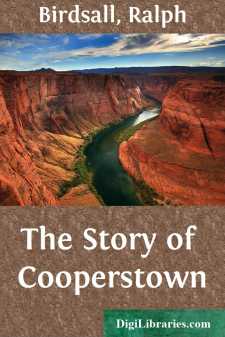Categories
- Antiques & Collectibles 13
- Architecture 36
- Art 48
- Bibles 22
- Biography & Autobiography 813
- Body, Mind & Spirit 142
- Business & Economics 28
- Children's Books 14
- Children's Fiction 11
- Computers 4
- Cooking 94
- Crafts & Hobbies 4
- Drama 346
- Education 46
- Family & Relationships 57
- Fiction 11829
- Games 19
- Gardening 17
- Health & Fitness 34
- History 1377
- House & Home 1
- Humor 147
- Juvenile Fiction 1873
- Juvenile Nonfiction 202
- Language Arts & Disciplines 88
- Law 16
- Literary Collections 686
- Literary Criticism 179
- Mathematics 13
- Medical 41
- Music 40
- Nature 179
- Non-Classifiable 1768
- Performing Arts 7
- Periodicals 1453
- Philosophy 64
- Photography 2
- Poetry 896
- Political Science 203
- Psychology 42
- Reference 154
- Religion 513
- Science 126
- Self-Help 84
- Social Science 81
- Sports & Recreation 34
- Study Aids 3
- Technology & Engineering 59
- Transportation 23
- Travel 463
- True Crime 29
The Story of Cooperstown
by: Ralph Birdsall
Categories:
Description:
Excerpt
CHAPTER I
THE INDIANS
The main street of Cooperstown traverses the village in a direction generally east and west. While the street and its shops are far superior to those of most small towns, the business centre, from which the visitor gains his first impression, gives no hint of the quaint and rustic beauty that makes Cooperstown one of the most charming villages in America.
Following the main street toward the east, one reaches the original part of the settlement, and the prospect is more gratefully reminiscent of an old-time village. In summer the gateway of the Cooper Grounds opens a pleasing vista of shaded greensward, while the cross street which runs down to the lake at this point attracts the eye to a half-concealed view of the Glimmerglass, with the Sleeping Lion in the distance at the north.
The historical associations of the village, from the earliest times, are centered in the Cooper Grounds. Within this space, when the first white man came, were found apple trees, in full bearing, which Indians had planted, showing an occupation by red men in the late Iroquois period. On these grounds the first white settler, Col. George Croghan, built in 1769 his hut of logs. During the Revolutionary War it was upon this spot that Clinton's troops were encamped for five weeks before their spectacular descent of the Susquehanna River. On this site William Cooper, the founder of the village, built his first residence, and afterward erected Otsego Hall, which later became the home of his son, James Fenimore Cooper, the novelist.
The Cooper Grounds
Beyond the Cooper Grounds, on the main street, the buildings seen on either hand belong to the earlier period of village history, except the Village Club and Library, which gracefully conforms to the older style. After passing the next cross-street, the main thoroughfare leads across the Susquehanna River, and, beyond the bridge, becomes identified with the old road to Cherry Valley. Keeping on up the incline, one finds Mount Vision rising before him, and begins to gain fascinating glimpses into the grounds of Woodside Hall, whose white pillars gleam amid the pines above the Egyptian gate-tower, and whose windows, commanding the whole length of the main street westward, reflect the fire of every sunset.
Just before reaching Woodside, one observes a road which makes off from the highway at the right, and runs south. Opening from this road to Fernleigh-Over, and quite close to the corner, is a small iron gate that creaks between two posts of stone. The gate opens upon a path which leads, a few paces westward, to a large, terraced mound, well sodded, and topped by two maple trees.
Sunk into the face of this mound is a slab of granite which bears this inscription:
White Man, Greeting!We, near whose bones you stand,
were Iroquois. The wide land
which now is yours was ours.
Friendly hands have given back
to us enough for a tomb.
These lines offer a fitting introduction to the story of Cooperstown. There is enough of truth and poetry in them to touch the heart of the most indifferent passer-by. No sense of pride stirs the soul of any white man as he reads this pathetic memorial of an exiled race and its vanished empire. From this region and from many another hill and valley the Indians were driven by their white conquerors, banished from one reservation to another, compelled to exchange a vast empire of the forest for the blanket and tin cup of Uncle Sam's patronage.
The mound in Fernleigh-Over is probably an Indian burial site of some antiquity. In 1874, when the place was being graded, a number of Indian skeletons were uncovered in various parts of the grounds. The owner of the property, Mrs. Alfred Corning Clark, caused all the bones to be collected and buried at the foot of the mound. Some years afterward she marked the mound with the granite slab and its inscribed epitaph.
The lines were composed by the Rev. William Wilberforce Lord, D.D., a former rector of Christ Church, in this village, once hailed by Wordsworth as the coming poet of America. He had written some noble verse, but wilted beneath the scathing criticism of Edgar Allan Poe, and after becoming a clergyman published little poetry....


